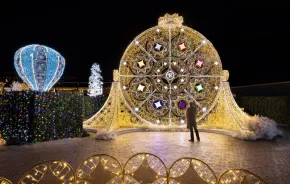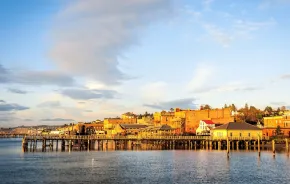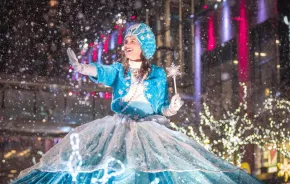For some, Seattle Center is more than a destination; it's their life's work.
Meet five people who make Seattle Center what it is, including the DJ pumping out good vibes, the landscape architect who helped design that crazy-cool slide, a facility maintenance supervisor who keeps the grounds going, the engineer ensuring the Monorail is safe and the pedicab driver always playing guide.

John Richards
KEXP DJ
“I tell parents, ‘Man, don’t give up on music.’ We give up so much of our lives for our children. We can’t give up on the creative things and inspiring things, and in fact, this is something that you can take along with your kids. There’s no reason they can’t listen to Fly Moon Royalty and grow up on the Rolling Stones and the Beatles and hip-hop.”
“My job represents me doing what I love. I tell kids all the time that if they just focus on what they love to do, they will be successful at it. Playing music for people is the best part of my job. Now there’s an added bonus: to look out on our Gathering Space to see people actually listening to the show live while having coffee at Marzocco.“
“We love it here. We started raising money three years ago and now we’ve been here five months, and it’s been a phenomenal success. For our grand opening, 12,000 people came.”
“When we used to come down here [Seattle Center], we would take our kids to the Children’s Museum or the Science Center and that was it. Now you have so many more things. It’s really become even more of a family-friendly place than in the past.”
Did you know?
In 2000, KEXP became the first radio station in the world to broadcast CD-quality music on the internet 24 hours a day, seven days a week.
— Gemma Alexander

Clayton Beaudoin
Principal at Site Workshop, which led the design of the Artists at Play playground
“Early on [after the playground opened], I crept my way close to these two dads who had just arrived with their 6- or 7-year-old kids, and one of them said [while looking at the climbing tower], ‘This can’t be legal.’ That was a big win because though we knew the climbing tower structure was safe, it’s the perception of risk that makes it a powerful experience for kids (and their parents).”
“Our goal for the project was to create a visually stunning play space that engaged all types of kids and their caregivers in unexpected ways. While the tower was an easy hook, the real victory would be dependent on how everything else ‘played.’ At one point during an early visit, I sat down on the big grass mound and I looked out over the playground at all the people spread out everywhere, and I could tell it was working. Then I closed my eyes. I heard big voices and little voices, excited, calm, happy and sad voices. And I heard music. Made by kids. It was all one big accidental symphony.”
“One of the things that this project does for Seattle Center is it creates a free place to kill an hour. Having an attraction that is explicitly free, the center has opened its doors a little wider to the rest of the city and become a more equitable place.”
“What I really love about playground design is the ability to engage kids in the design of their environment. It’s this collaboration with kids (and artists, manufacturers, contractors, owners) that I’m fascinated by. And in the end, I find it literally awe-inspiring to watch kids play and to see new worlds unfold around the framework of the playground.”
Did you know?
To inform its vision, the team of developers and artists that designed Artists at Play talked to more than a hundred kids about what they wanted to see — and hear — in the playground.
— Elisa Murray

Beth Duncan
Assistant facility maintenance supervisor, Seattle Center
“Most of my career here has been as a landscape supervisor. I’m really a horticulturist, a gardener, in my heart’s soul. I still oversee the gardening and the landscapes, but at a much higher level; I’m not involved in the day-to-day worry about every blade of grass and perennial that gets stepped on.”
“Problem solving is the big thing that I do and that people who work under me do. We’re always trying to fix things or figure out a way to make something work. We have all these events and we have to meld everything together. I enjoy that a lot. It’s always interesting.”
“I wish that kids knew that there are other kinds of work in the world that can be very fun and satisfying besides just some kind of high-tech thing. For me, my reward has been making beautiful spaces for people in Seattle to enjoy.”
“My best days are in late spring, when the grounds are just pristine. The lawns are beautiful, the shrubs are in bloom, we haven’t had a major festival yet, and everything is fresh. If you come before 11 o’clock in the morning you pretty much have the place to yourself.”
Did you know?
Unit 19 is a group of engineers who work at Seattle Center 24 hours a day, seven days a week, to keep all of the systems running.
— Gemma Alexander

Eno Yliniemi, Ph.D.
Chief systems engineer, Seattle Monorail Services
“The Seattle monorail embodies a futuristic optimism. It’s a connection from the past to the present to the future. It showcases great things from the past, it’s still serving us today and it’s a model for what can be in the future. I call it the ‘little time machine.’”
“These are the same trains that were built in West Germany in 1961, shipped to New York City and then put on railcars to Seattle. Cranes picked them up and put them on the tracks 54 years ago. The fact that we’ve been able to reuse these trains, fix and upgrade them and give them new life, is actually very environmentally friendly. A lot of people think of it as a toy train or just a novelty train, but really what it is [is] a full-scale transit system that has a short run.”
“One of the unique things about the monorail is that you can get right up next to the driver in the front. You can get that front-row seat and look straight out. And our drivers will let the little kids who sit up there honk the horn. Those spots are coveted.”
“My favorite part of the job is solving a problem and seeing that it has been helpful and useful, and that people are enjoying it.”
Did you know?
Each monorail train has run for more than 1 million miles. The monorail can hit speeds of more than 50 miles per hour (though the average is 35 mph because of the short 1-mile run).
— Elisabeth Kramer

Edward Ingram
Owner, Tride Pedicab
“Seattle is the first North American city with the documented commercial use of pedicabs, and it happened because of Seattle Center. A guy [businessman Stan McDonald] brought them over for the 1962 World’s Fair.”
“As far as the evolution of Seattle Center itself, [when I’m giving pedicab tours] I like to discuss the juxtaposition of the Cold War buildings vs. the post–Cold War buildings. When you look at the Space Needle, with its sturdy deep bolts, classic tan color and reach-for-the-sky attitude, you really get a sense of who we were as Americans in 1955–1962. Then you can walk a couple hundred feet and look at Frank O. Gehry’s EMP, with its wild lines and colors. It says a lot. How much safer we feel here now, for one, but also it shows the importance that has been put on art, sculpture and music in the city since the World’s Fair.
"I took up pedicabbing as a part-time job because for the first time since my youth, I was physically able to do it. It keeps me focused and centered. The thing is, and it took me awhile to put this together, but my mother is 76 years old and she still gives walking tours of my hometown, so we kind of do the same thing. It’s weird, right?”
Did you know?
The 1963 Elvis Presley film set in Seattle, It Happened at the World’s Fair, includes a pedicab.
— Elisabeth Kramer
Secrets to Seattle Center: The Ultimate Guide
-
Best Things to Do at Seattle Center by Age — a tots-to-teens guide to top attractions
- The Quiet Side of Seattle Center — 6 pockets of green space, history and art to discover
-
Sky High? How to Do the Space Needle Right — Make the most of your pricey elevator ride
- Seattle Center Stories — A KEXP DJ, playground designer, gardener, engineer and pedicab driver tell the stories behind the center
- James Whetzel, Seattle Center's Music Man — Did you know Seattle Center International Fountain has its own DJ?
- Festál: Seattle Center's Window on the World — Behind the scenes at the extraordinary 19-year-old cultural festival series that is Festál
- A Summer Day in the Life of Seattle Center — And you think you're busy










